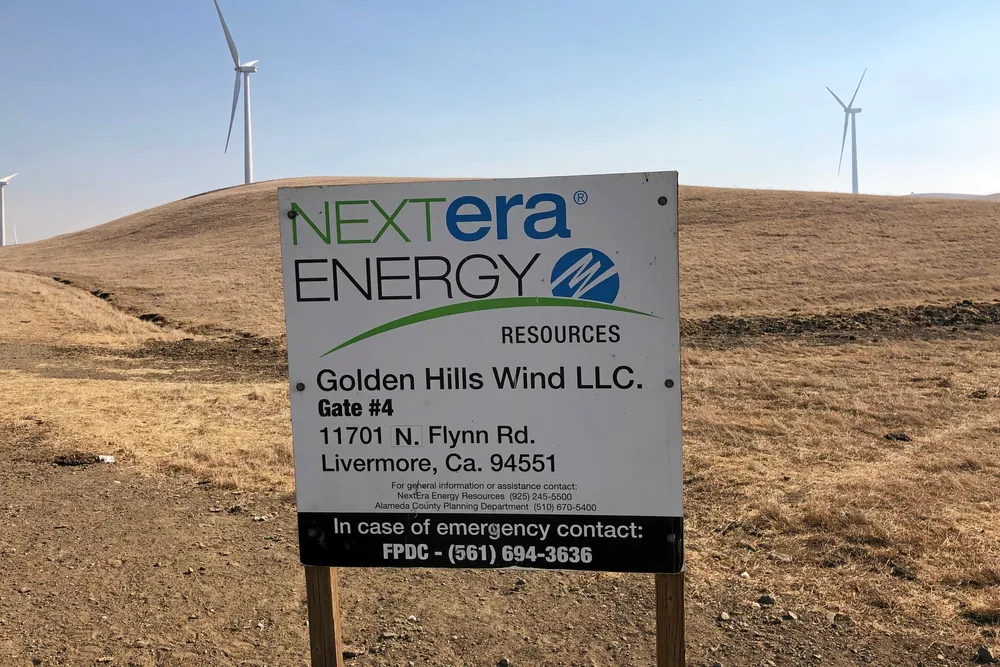NextEra tells Wall Street why green power not gas will keep US lights on
The power industry pacesetter forecasts country will need 460GW of new generation capacity with only 16% coming from fossil fuels

Power industry pacesetter NextEra Energy (NEE) estimates that 84% of 460GW of new generation capacity the US will need by 2030 will come from grid-scale solar, storage, and wind.
This includes 230GW of solar, 80GW of wind, and 75GW of storage. Natural gas will provide the rest (75GW), executives told Wall Street analysts at NextEra’s Renewable Development Day at corporate headquarters in Florida.
NextEra does not believe utilities will build new coal-fired capacity despite efforts by President Donald Trump to rekindle their interest.
Trump is openly hostile toward wind and views utility-scale solar as requiring too much land and uneconomic versus fossil fuels. He has not taken a strong stance on storage, but his threats to slap high tariffs on imported battery materials would likely raise sector costs.
The administration's stance is unclear over whether it would support potential legislation to end federal tax credits for battery manufacturing in the US.
In 2024, gas had a 43% share of US electricity generation, renewables including hydro 24%, nuclear 18%, and coal 15%.
To achieve NextEra’s five-year new build numbers would require the country to install a yearly average 46GW of solar capacity versus an all-time high of 41.4GW in 2024, and 16GW of wind, which it attained only once in 2020 (16.9GW). Wind additions were 3.9GW last year.
NextEra’s estimate includes offshore wind, a sector it has avoided as “bad business.” Offshore wind faces an uncertain future under President Donald Trump, a long-time critic.
Storage additions would average 15GW annually, compared with 11.3GW in 2024, the first year the US installed double-digit gigawatts.
NextEra’s portfolio includes Energy Resources, the largest renewables developer and generator outside China, and Florida Power and Light, the nation’s largest investor-owned electric utility by customers and electricity sales.
The company highlighted the practical advantages of renewables within the energy environment the US faces that include deployment and economic attractiveness.
NEE estimates it can build on average a wind farm in one year, a storage facility in 15 months, and a solar project in 18 months.
"Renewables are ready to go right now because they've been up and running," CEO John Ketchum told a conference earlier this month, noting they have a cost advantage.
Gas a minor player
While the US has abundant reserves, natural gas will account for only 16% of new generation capacity in NextEra’s forecast. Why?
“There is a lot of demand for gas turbines right now. You have to get in a long line. It has pushed the prices up,” said Ketchum. NextEra is a leading owner-operator of gas-fired power plants.
“We built our last gas-fired facility in 2022, at $785/kW. If we wanted to build that same gas-fired combined cycle unit today… $2,400/kW,” he said. “The cost of gas-fired generation has gone up three-fold.”
NextEra told analysts that after years when relatively few gas-fired plants were built, contractors lost numerous workers that had know-how to construct those facilities. Some retired or transferred to other sectors.
"When you look at gas as a solution, to get your hands on a gas turbine, and actually get a built brought to market, you're really looking at 2030 or later," said Ketchum, and only in certain “pockets” of the country.
Natural gas capacity additions have averaged 6.4GW this decade but declined to 2.4GW in 2024, down from 11.3GW the previous year.
Trump wants to ramp annual gas installs to at least what they were in 2018 (20.1GW) during his first term, although they declined to 8.6GW and 6.3GW in his final two years in office.
NextEra in January announced a framework agreement with GE Vernova to co-own gas-powered generation assets whose energy would be contracted long-term to high load customers.
This would help meet growing power demand by pairing low-cost renewables for energy with gas-fired generation for capacity, according to Ketchum.
NextEra believes there is no single solution to meet the country’s surging energy demand driven by factors including data centre and economic growth, electrification of industry, and new manufacturing activity.
“It's really important that we make the right decisions around energy policy because we are seeing in the market today is that we want to build it all,” he told the conference.
After NextEra’s briefing, investment bank Morgan Stanley said its broad capability set across infrastructure solutions positions it as “uniquely advantaged” as a partner to both utilities and end customers.
“NextEra has a very large and diverse asset base across renewables, gas, nuclear, and transmission, and also brings a development platform, balance sheet, pipeline and power market expertise, supply chain, and construction capabilities,” it said in a research note.
(Copyright)